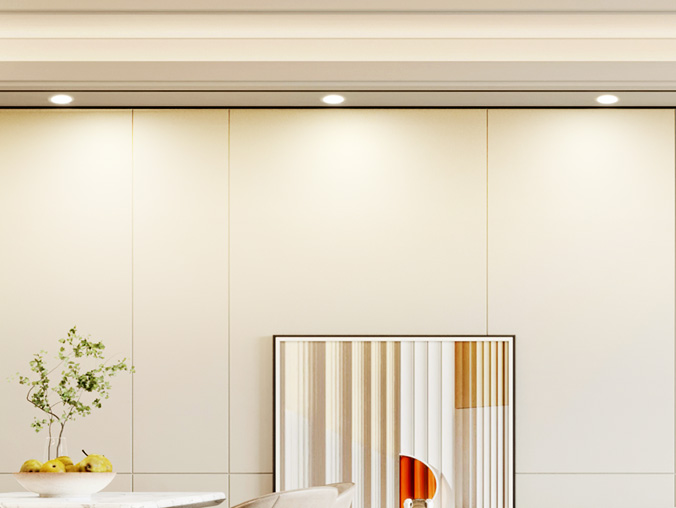

Yes, recessed slim panel led downlight is highly suitable for false ceiling gaps—especially ultra-thin, gap-optimized models like IMIGY’s Wave Down Lights and Grace Down Lights. False ceiling gaps (the space between the false ceiling and the original ceiling) are typically narrow (50–100mm deep), making bulky downlights impossible to install. A recessed slim panel led downlight solves this with its ultra-slim profile, shallow installation depth, and compact structure—fitting perfectly in limited gaps without compromising brightness or safety. Whether you’re renovating a living room with a suspended false ceiling or adding lighting to a kitchen’s drop ceiling, IMIGY’s slim downlight designs ensure seamless integration, even in the tightest gaps. Below is a detailed breakdown of suitability, product advantages, and practical tips.
1. Key Reasons for Suitability in False Ceiling Gaps
Recessed slim panel led downlight is ideal for false ceiling gaps due to three core traits: first, ultra-thin depth—top models (like IMIGY’s Wave) are only 30–50mm thick, matching the typical 50–80mm gap depth of residential false ceilings. Second, lightweight design—most slim panels weigh 0.5–1kg, so they don’t strain the false ceiling’s lightweight frame (unlike heavy traditional downlights). Third, recessed installation—the panel sits entirely within the gap, with no part protruding below the false ceiling, avoiding damage to the ceiling’s structure or appearance. Unlike cob led downlight replacement units that may have bulkier heat sinks, slim panels prioritize gap compatibility without sacrificing LED brightness.
2. IMIGY Down Lights: Perfect for False Ceiling Gaps

a. Wave Down Lights (Ultra-Slim Recessed Panel)
30mm Ultra-Thin Depth: IMIGY’s Wave Down Lights (a flagship recessed slim panel led downlight) have a depth of only 30mm—fitting even the narrowest false ceiling gaps (50mm+). The panel’s compact structure places all components (LED chips, driver) within this slim profile, so there’s no need to widen the gap or modify the false ceiling. It uses a low-profile aluminum frame that dissipates heat efficiently, ensuring safety even in enclosed gaps (no risk of overheating the ceiling material).
Gap-Friendly Installation: Wave’s installation requires only a 150–200mm cutout in the false ceiling—standard for most slim panels. The included spring clips secure the panel to the false ceiling’s frame (no screws needed), so you don’t have to drill into the gap’s supporting structure. As a non-smart slim downlight, it has no extra wiring or bulky modules, keeping the gap space free for other components (e.g., wiring, insulation).
b. Grace Down Lights (Slim Smart Panel)
50mm Depth + Smart Features: For false ceiling gaps that are slightly deeper (60–100mm), Grace Down Lights (a smart led downlight with slim panel design) are ideal. At 50mm deep, they fit comfortably in larger gaps while still being slimmer than traditional smart downlights (which often exceed 80mm). Grace’s built-in Wi-Fi module is integrated into the slim profile—no extra space needed in the gap—letting you control brightness and color via app (a key advantage over basic recessed slim panel led downlight models).
Gap-Safe Wiring: Grace’s wiring uses a compact connector that fits in narrow gaps, avoiding tangled wires that could block airflow (critical for preventing heat buildup). It also works as a cob led downlight replacement—if you’re upgrading old COB downlights in a false ceiling, Grace’s slim depth and compatible cutout size make installation easy, with no need to adjust the gap.
3. Practical Tips for Installation in False Ceiling Gaps
Measure Gap Depth First: Use a tape measure to confirm the false ceiling gap depth—choose Wave (30mm) for 50–70mm gaps, and Grace (50mm) for 70–100mm gaps. Never force a thicker downlight into a narrow gap (risk of ceiling damage).
Check Ceiling Material: For lightweight false ceilings (e.g., gypsum board), use the included spring clips (like Wave’s) to avoid putting stress on the material. For sturdier ceilings (e.g., aluminum panels), Grace’s screw-in brackets (optional) provide extra stability.
Avoid Overcrowding the Gap: Install one recessed slim panel led downlight per 1–2㎡ of ceiling—too many lights can fill the gap with wiring and heat sinks, increasing fire risk. Pair with ambient lighting (e.g., strip lights) if more brightness is needed, instead of adding extra downlights.
4. Common Misconceptions to Avoid
Recessed slim panel led downlight lacks brightness for gaps: No—IMIGY’s Wave (18W, 1800 lumens) and Grace (20W, 2000 lumens) provide enough brightness for living rooms and bedrooms, even in enclosed gaps.
Smart downlights are too bulky for gaps: Incorrect—Grace’s smart led downlight design keeps depth at 50mm, fitting most false ceiling gaps while offering app control.
Recessed slim panel led downlight is the perfect choice for false ceiling gaps—and IMIGY’s Wave Down Lights (ultra-slim non-smart) and Grace Down Lights (slim smart) stand out for their gap compatibility. Their thin profiles (30–50mm), lightweight designs, and recessed installation ensure they fit seamlessly in narrow gaps without damaging the false ceiling or sacrificing functionality. Whether you need a basic slim downlight (Wave) for a small gap or a smart downlight (Grace) for added control, IMIGY’s models eliminate the hassle of modifying gaps or hiring professionals. Plus, as a cob led downlight replacement, they let you upgrade old lighting in existing false ceilings with minimal effort. With IMIGY, you don’t have to compromise on style, brightness, or smart features to fit lighting in tight false ceiling gaps.
It is recommended that you upgrade the latest browser
 Chrome
Chrome Firefox
Firefox Edge
Edge